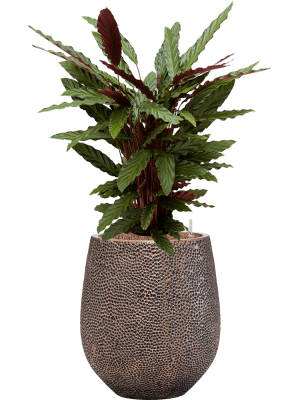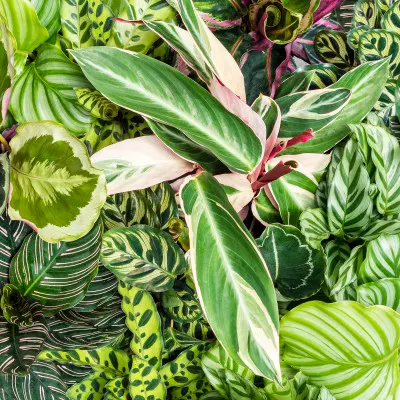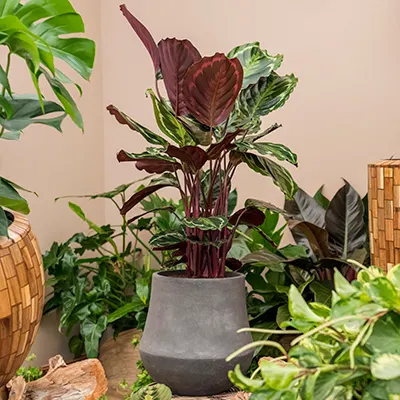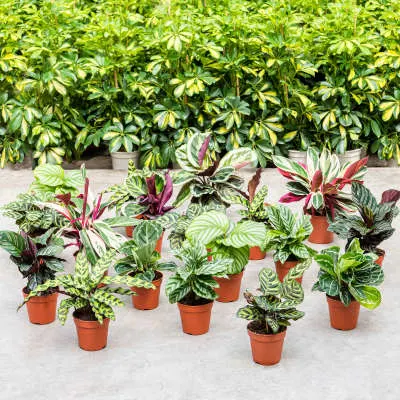
Calathea rufibarba 'Wavestar' in Baq Opus Hit
Hydroculture
CC0009508
The Calathea is a beautiful plant with a unique appearance and very detailed leaves. The leaf markings vary from dark to almost white stripes and from green to purple edges. This beauty can be very picky, so in this blog we would like to give you some tips for the care of the plant.
The Calathea originates in the jungles of South America and in the Amazon region. The plant is usually not very big and grows naturally in the shade of higher plants and trees. There are many different species of Calathea, which ensure that the plant has a great diversity of colours and leaf shapes. The most common colours are green and purple; the shape is mainly oval and round. A special feature of the Calathea is the fact that its leaves are 'alive' - hence the nickname 'Living Plant'. In the evening the plant closes its leaves and in the morning they unfold again.

Calathea's natural habitat is quite sheltered and in the shade. The plant does not need a lot of light and does not like sunlight very much. The best place for a Calathea is in the half shadow or shade, without direct sunlight. It is best to place the plant near a window facing north. With an east or west-facing window, a distance of about two to four metres from the window should be guaranteed; with a south-facing window, at least three metres. If the location is too sunny, the leaf markings will disappear. If the location is too dark, the leaf will turn green because green leaves can absorb more sunlight than leaves with markings. The detailed leaf markings will then also fade.
The Calathea needs a relatively large amount of water. It is best to regularly give the plant small amounts of water. In summer, this is about twice a week and in winter a little less. It is important that the soil is always slightly moist, but there should not be a layer of water at the bottom of the planter, as this could cause root rot. When the soil starts to dry out or when the leaves start to droop or curl, the plant needs water.

Calatheas, due to their origins in the warm South American rainforests, need a warm environment with high humidity. The minimum temperature for the Calathea is 15 °C, but the plant will grow better at a temperature of around 20 °C. Regular watering improves the health of the plant and can prevent brown leaf edges. Do not place the Calathea near a radiator or in a draughty spot, as the humidity will soon be too low there.
Calatheas do not usually grow very large, so pruning is not necessary. Most species can grow to a height of about 60 centimetres and a few, such as the rufibarba, grow to 90 centimetres. Because the high humidity is difficult to guarantee in some rooms, the Calathea can quickly develop brown leaf edges and dry leaves. Leaves that are no longer attractive can be cut off low to the base.
Calatheas produce new leaves in the spring and summer. This process takes a lot of energy and therefore it is recommended to give the plant nutrition in this period. When the Calathea has sufficient nutrients it will also keep its beautiful leaf colours. When it comes to nutrition, it is best to use universal houseplant nutrition. You will find the correct dosage on the packaging. In autumn and winter, the plant does not need any nutrition, because it does not produce new leaves. Too much nutrition can be harmful to the roots.

The Calathea has many different varieties. Below you will find more information about the most common or most sold varieties at Nieuwkoop Europe.
The leaves of the Calathea rufibarba have wavy edges and are elongated. This plant is also called the 'velvet Calathea' because of the soft structure of the underside of the leaves. The most common variety of rufibarba is 'Wavestar', which has a purple underside. The 'Blue grass' has completely green leaves.
The Calathea crocata is a flowering variety of the Calathea. Popular is the 'Tassmania' variety, which has beautiful bright orange flowers.
Until recently, Calathea Lancifolia was the correct name for this Calathea. The plant is also called rattlesnake plant or peacock plant. The plant has a unique pattern of dark green spots on the leaves.
The Calathea makoyana is native to Brazil. The leaves are quite large and round in shape and have a pattern of dark green stripes. These stripes take on a purple glow on the underside of the leaves.
The Calathea ornata is also called the 'Pinstripe Plant'. The plant owes this name to the long, dark green leaves with beautiful light pink stripes.
This orbifolia is a popular Calathea and is a real eye-catcher because of its broad leaves. The rounded leaves can be up to 30 centimetres wide and have soft white lines.
'Fusion White' is a special variety of Calathea. The top of the leaves have a beautiful pattern of dark green, light green and white stripes. The underside of the leaves has a purple colour.
